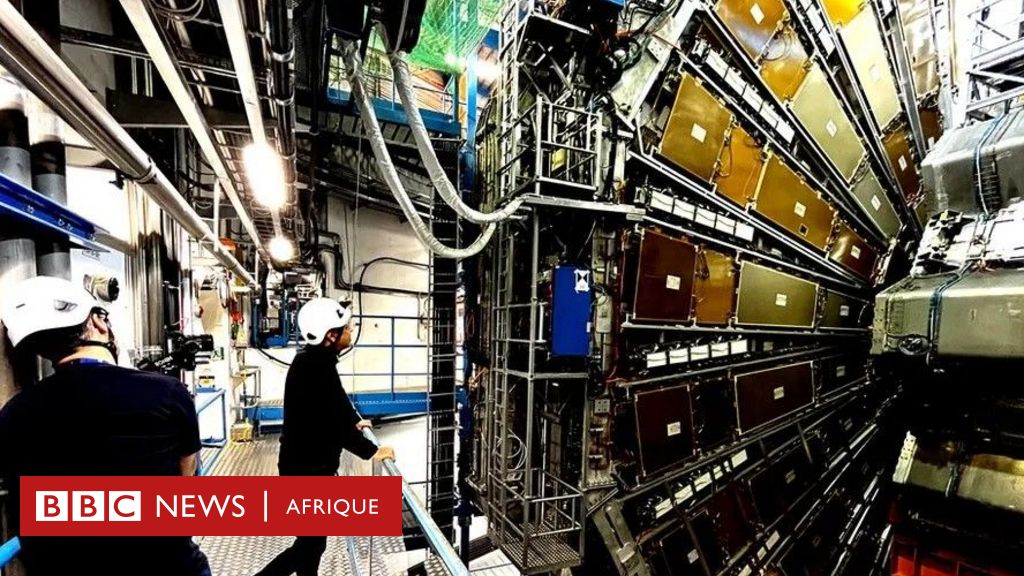
Physics: A giant atom breaker to find the missing 95% of the universe
Image credit, Kate Stevens/BBC News
The ATLAS detector, which is about the size of a tanker truck, is used to measure some of the smallest objects in the universe.
- author, Written by Pallabh Ghosh and Kate Stevens
- Role, BBC News, CERN, near Geneva
Researchers at the world's largest particle accelerator in Switzerland have submitted proposals to create a new, much larger supercollider.
The goal is to discover new particles that will revolutionize physics and provide a better understanding of how the universe works.
If approved, it will be three times larger than the current giant machine.
But its £17bn cost has raised eyebrows among some, with one critic describing the spending as “reckless”.
This money – which represents only the initial cost of construction – will come from member states of the European Organization for Nuclear Research (CERN), including the UK, and some experts question the economic merits of such an approach.
The Large Hadron Collider's (LHC) greatest achievement was the discovery of a new particle, the Higgs boson, in 2012. But since then, its ambition to track down two hallowed goals in physics – dark matter and dark energy – has proven elusive and some researchers believe there are cheaper solutions.
The new machine is called the Future Circular Collider (FCC). The director-general of the European Organization for Nuclear Research, Professor Fabiola Gianotti, told BBC News that if the project was approved, it would be a “beautiful machine”.
“It is a tool that will allow humanity to make tremendous progress in answering fundamental physics questions about our knowledge of the universe,” she said. “And to do that, we need a more powerful tool to answer these questions.”
Pallabh Ghosh and Kate Stevens go inside the world's largest particle accelerator to find out why scientists want a bigger accelerator.
CERN is located on the border between Switzerland and France, near Geneva.
The LHC is a circular underground tunnel with a circumference of 27 km. It accelerates the interior of atoms (hadrons) clockwise and counterclockwise to speeds close to the speed of light, sometimes causing them to collide more violently than any other atom crusher in the world.
Smaller subatomic particles resulting from collisions help scientists understand what atoms are made of and how they interact with each other.
Based on a revolutionary discovery
The discovery of the Higgs boson by the supercollider, more than ten years ago, was a real revolution.
The existence of a building block that gives shape to all other particles in the universe was predicted in 1964 by British physicist Peter Higgs, but was not discovered at the Large Hadron Collider until 2012. It is the final piece of the current subatomic physics puzzle. A theory called the Standard Model.
The large FCC is proposed to be created in two phases. The first will begin operating in the mid-2040s and will collide with electrons. It is hoped that the increase in energy will produce large numbers of Higgs particles that scientists can study in detail.
The second phase will begin in the 2070s and will require more powerful magnets, which are so advanced that they have not yet been invented. Instead of electrons, heavier protons will be used to search for new particles.
The FCC's circumference will be roughly three times that of the LHC's, or 91 kilometers, and its depth will be twice that. It must be deeper to prevent stronger radiation from higher energies from reaching the surface.
So why do they need a Larger Hadron Collider?
Because the Large Hadron Collider, which cost £3.75 billion to build and which began operating in 2008, has not yet been able to find particles that can explain 95% of the universe.
Scientists are still searching for two big unknowns: A force called dark energy, which acts as a counter to gravity and pushes objects in the universe like galaxies apart. The other is dark matter, which cannot be detected but whose presence is felt by gravity.
“We are missing something important,” Professor Gianotti tells us.
According to her, the FCC is necessary because the discovery of these dark particles would make it possible to develop a new, more complete theory of how the universe works.
More than 20 years ago, many researchers at CERN predicted that the LHC would find these mysterious particles. This was not the case.
Critics, such as Dr. Sabine Hosenfelder of the Frankfurt Institute for Advanced Studies, say there is no guarantee the new collider will succeed.
Particle physics is a large and well-funded field of research for historical reasons, because it evolved from nuclear physics.
The UK government's former chief scientific adviser, Professor Sir David King, told BBC News he believed spending £17bn on the project would be “reckless”.
As the world faces threats from the climate emergency, wouldn't it be wise to direct these research dollars toward efforts to create a manageable future?
Image credit, Adam Hart Davis / Scientific Image Library
Particle beams are accelerated inside the blue tube located under the French-Swiss border.
Particle physicists themselves are debating whether the Giant Ring Collider is the best option.
Professor Aidan Robson, from the University of Glasgow, told the BBC that a collider built in a straight line would be cheaper.
“There are three main advantages. Firstly, a linear machine can be built step by step. Secondly, the cost profile will be completely different – so the cost of the initial stage will be lower – and thirdly, the tunnel is shorter, which makes it possible to go faster,” he said.
But the FCC is the preferred option for CERN, which is evaluating reactions to its proposal from the 70 member states, which would have to pay for the new device.

“Organizer. Social media geek. General communicator. Bacon scholar. Proud pop culture trailblazer.”
